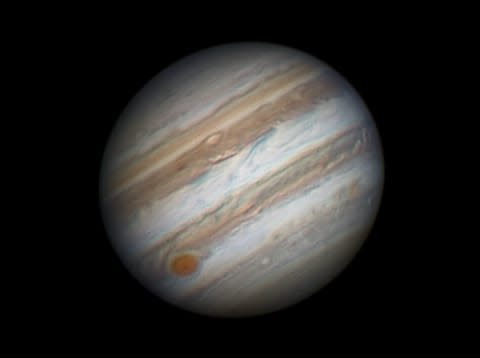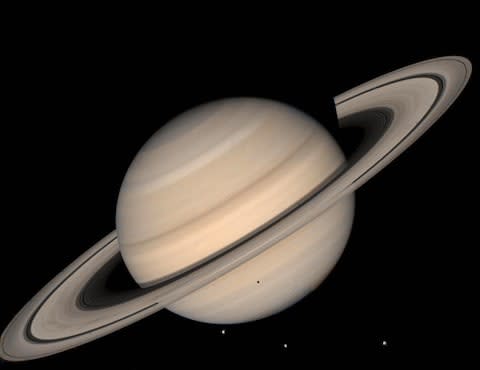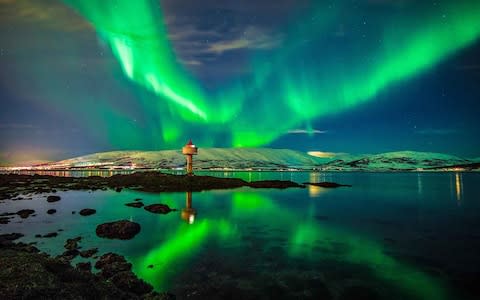Missing the US solar eclipse? Here are 11 more heavenly spectacles to mark in your diary

The USA will witness a solar eclipse today, which will glide right across the torso of the country, from Oregon on the west coast to South Carolina on the east. If you're lucky enough to be there, you can read about a selection of places where you can enjoy the spectacle here. Alternatively, here are a few other heavenly events for your diary...
Eta Aquariids: May 6 2018
We've all heard of Halley's Comet. It's the celestial phenomenon which appears once every 74-79 years, and is so visible to the naked eye that it was stitched into the Bayeux Tapestry - its streaking across the sky in the autumn of 1066 being seen as a bad omen for England's King Harold. Alas, it isn't due to reemerge into our sightlines until 2061 - but one of its side-effects can be admired every year. The Eta Aquariids are a meteor shower which broke away from the comet in the distant past. Earth ploughs a path through them every April and May, usually between April 19 and May 28. They should hit their next peak on May 6 2018 - and are best seen just before dawn.

The Leonids: November 15-20 2017
Comet Tempel-Tuttle is a little more regular in paying Earth a visit, shooting past once every 33 years. It will next be in town on May 20 2031. In the meantime, you can enjoy one of its most splendid consequences - the Leonid meteor shower, which spins its magic each November as Earth passes through the debris field left by the comet's passage. November 15-20 is the key juncture for seeing these bright particles strafing the sky - with the night of November 17-18 likely to be the optimum window.
The Perseids: Until August 24 2017
A similar process involving lost fragments of the Comet Swift-Tuttle (not, alas, due back close to Earth until July 12 2126), the Perseids illuminate the firmament every July and August, generally from July 17 to August 24. Yes - this week.

Transit of Mercury: November 11 2019
At times, our solar system is a simple place - eight major planets (poor Pluto was reclassified as a "dwarf planet" in 2006) revolving around the sun. At times, some of the other seven can briefly obscure Earth's view of our source of warmth and light - and be visible as a speck of black against the wider backdrop of orange. Mercury, as the innermost planet of the eight, is the most regular repeat offender on this score, taking just 88 days to complete its orbit. It is also the smallest of our neighbours, which means you need a decent telescope to see its transit. The next of these is scheduled for November 11 2019. Then it’s a wait of another 13 years, until November 13 2032.

Mars at opposition: July 27 2018
There is never a Transit of Mars, because our nearest planetary neighbour is further from the sun than Earth (though perhaps, one day in the far future, our descendants will watch the Transit of Earth from Mars). It does, however, treat us to regular doses of "opposition" - the moment when it and the sun are on directly opposing sides of our home planet. These are also effectively the times when that big ball of red rock is closest to us. Because we orbit the sun at a faster rate, this occurs roughly once every 26 months. Every 15-17 years, opposition happens within a few weeks of Mars's "perihelion" - the point when it is closest to the sun. In these windows, the sun and Mars appear on opposite sides of the sky, Mars setting in the west as the sun rises in the east. We are due another of these extravaganzas on July 27 2018 - on which day, Mars will be a mere 36 million miles away. "Mere" is an appropriate word here. Mars never comes nearer than 34 million miles - so this will be a relatively close encounter.
Jupiter at opposition: May 9, 2018
The largest member of the Solar System Club will perform the same neat tag-team trick with Earth and the sun next May. It should be particularly visible from London between 9.19pm and 4.31am on the night of May 9-10. There is always a decent chance of seeing Jupiter, as it is generally considered the fourth brightest object in our firmament, after the sun, the moon and Venus. Because Earth spins around the sun far more swiftly than Jupiter, it gives it a fly-past every 398.9 days - so the biggest planet comes into opposition every 13 months. Expect it to be back in line on June 10 2019 too.

Saturn at opposition: June 27, 2018
Yes, Saturn does this too. Its next love triangle with Earth and the sun is scheduled for June 27 next year - when it will be in the heavens above London between 10.41pm and 3.23am (on June 28). It will, however, be low in the sky if viewed from the capital (or indeed, anywhere in the United Kingdom) - never higher than 16° above the horizon. You will need to be further south - in Spain, at least - for a better chance of a sighting.

Aurora Borealis: November 2017-March 2018
Hugely familiar in an era when clever cameras and advances in science have tamed some of their mystique, the Northern Lights nonetheless have the capacity to amaze if seen on a clear evening under cold skies. They occur, of course, when charged solar particles strike the magnetic fields above the Earth's poles - and, in the case of the Aurora Borealis, are inevitably more visible the greater your proximity to the North Pole. Iceland, Norway, Sweden and Finland are all good ports of call if you wish to see them, but your best bet, without leaving Europe, is the Norwegian archipelago of Svalbard, which loiters at a latitude of between 74°N and 81°N. Discover The World (01737 214 250; discover-the-world.co.uk) offers a six-day "Tromso and Svalbard" break, available between November and April, which is designed to collide with the Northern Lights. From £1,204 per person, including three days on Spitsbergen, as well as flights.

Aurora Australis: March-August 2018
And if you head south, you can encounter the Aurora Australis on the same basis - in countries such as Chile, Argentina, Australia and New Zealand. In truth, none of these countries lies anywhere as near to the polar extremes as Svalbard does in the north, and venturing to the Antarctic during the Southern Hemisphere winter is difficult and very expensive for tourists. But both Australia and New Zealand enjoyed a Southern Lights spectacular earlier this year, and may do so again in 2018. Audley Travel (01993 838 810; audleytravel.com) sells a "Classic Tasmania Self-Drive" holiday, available throughout the year, which takes 13 days to dissect Australia's most southerly - and thus most Aurora-friendly - state in detail. From £3,920 per person, including flights.

The Maine Solar System Model: Any time
You don't have to look to the skies for an understanding of our solar system. A road trip through New England can be just as enlightening - particularly if you head to its biggest state to admire the educational curiosity that is the Maine Solar System Model (pages.umpi.edu/nmms/solar/). This is a clever but straightforward idea - the brainchild of the University of Maine - which sees nine planets (Pluto is included) dotted along a 40-mile stretch of US Route 1 as it cuts north between the towns of Houlton and Presque Isle in the north-east of the state. The "map" is laid out at a scale of 1:93,000,000, with the planets placed at the relevant intervals along the highway. These are also "in scale". Thus, Mercury is a pinprick on a pole, and hard to spot, while Jupiter is a fat orb, almost impossible to miss. There is a certain quirky fun to locating them all - including the sun, which is "hidden" in a stairwell of Folsom Hall on the university's Presque Isle campus. America As You Like It (020 8742 8299; americaasyoulikeit.com) offers a 14-night "Complete New England" trip which would allow for a dash to the area. From £1,279 per person, including flights, car and hotels.
Transit of Venus, December 10-11 2117
The missing link which "connects" Mercury and Earth, Venus also occasionally lodges itself between us and the sun. Alas, its transits are both frequent and exceedingly rare. In that, like London buses, two occur in quick succession, followed by a very long wait. Generally, this means two transits in eight years as part of a repeating 243-year cycle. And sadly, we've had our quota for this century - Venus flitted across the sun on June 8 2004, and again on June 5-6 2012. She won't be back on this basis until December 10-11 2117 and December 8 2125 - but you can tell your great-grandkids to set their clocks. Or whatever it is they use to tell the time in the early 22nd century.



